

New Open Innovation, Collaborative Innovation - innovation-3. What It Really Means to Be a Chief Innovation Officer. Increasingly, companies are creating formal innovation roles outside the R&D department.

In a Cap Gemini study from 2012 of 260 organizations, 43% of respondents said they had a Chief Innovation Officer or similar, up from 33% the year before. Below the C-suite level, local leaders across the organization are busily creating dedicated innovation roles, with titles such as Innovation Manager, Innovation Director, or VP of Innovation. More people than ever before, irrespective of their function, now face the option of taking an innovation job. Which brings up an obvious question: What does it take to succeed in such a job? The Fundamental Shortcoming With How We View Innovation. "Do you think CINO’s will be around in five years?
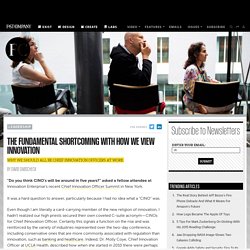
" asked a fellow attendee at Innovation Enterprise’s recent Chief Innovation Officer Summit in New York. It was a hard question to answer, particularly because I had no idea what a "CINO" was. Even though I am literally a card-carrying member of the new religion of innovation, I hadn’t realized our high priests secured their own coveted C-suite acronym—CINOs for Chief INnovation Officer. Certainly this signals a function on the rise and was reinforced by the variety of industries represented over the two-day conference, including conservative ones that are more commonly associated with regulation than innovation, such as banking and healthcare.
Indeed, Dr. From Fad To The Future Corporate history is a litany of excessive and often regrettable crazes. But the emergence of CINOs specifically and the increasing interest in innovation generally feels different; mainly because this growth is driven by push factors as much as by pull factors. The #NewEraBiz - Blog. The walls are coming down.
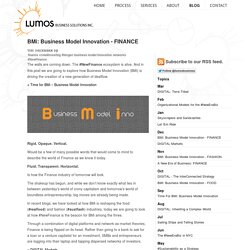
The #NewFinance ecosystem is alive. And in this post we are going to explore how Business Model Innovation (BMi) is driving the creation of a new generation of dealflow. + Time for BMi – Business Model Innovation. Ideas from the fringe. Where do ideas come from?
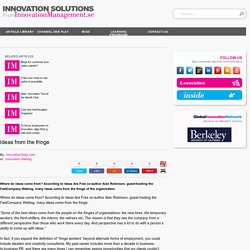
According to Ideas Are Free co-author Alan Robinson, guest-hosting the FastCompany Weblog, many ideas come from the fringe of the organization. Where do ideas come from? According to Ideas Are Free co-author Alan Robinson, guest-hosting the FastCompany Weblog, many ideas come from the fringe: “Some of the best ideas come from the people on the fringes of organizations: the new hires, the temporary workers, the third-shifters, the interns, the retirees etc. The reason is that they see the company from a different perspective than those who work there every day. In fact, if you expand the definition of “fringe workers” beyond alternate forms of employment, you could include ideation and creativity consultants. The bottom line is that I think Alan Robinson is absolutely correct — ideas do come from the fringe, and organizations need to have processes in place to collect, evaluate and act on them — no matter what the source.
Innovation happens at the fringe. Constructing New Global Paradigms. Behind the launch of LUMAN, a ‘new’ kind of innovation group.

What do you stand for? Think about it for a moment or two. Meditate on it, if you like. Write it down, if you can. This is probably an ongoing thought and (r)evolving set of questions for many of you who are reading this. I’ll share with you what ‘I’ stand for: The Full-Stack Startup. Q: So what’s a full stack startup?

You’ve mentioned that it’s a new, important trend, and a pattern of startups we’ve been seeing over the past couple of years. Chris Dixon: The old approach startups took was to sell or license their new technology to incumbents. The new, “full stack” approach is to build a complete, end-to-end product or service that bypasses incumbents and other competitors. A good example from big companies is Apple versus Microsoft. Choose the Right Innovation Method at the Right Time. In the industries plagued by the most uncertainty, how do companies hold on to their ability to innovate?

And how do they achieve, and keep, an innovation premium in the market? We found that managers who help their firms create and maintain an innovation premium use a different set of tools than their more traditional counterparts — tools honed in start-ups and specifically designed to manage uncertainty. Although these tools come by many different names (e.g., lean startup, design thinking, discovery-driven planning, agile software, and so forth) they actually have a remarkable commonality. Too Fast, Too Furious. For more than two centuries, time has been felt to be passing more and more quickly.
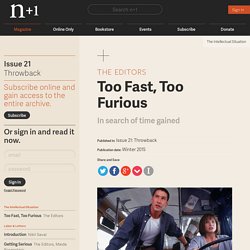
Scholars tell us that since the twin revolutions of the 18th century — industrial and political — a general sense of time speeding up has been recorded with regularity in documents of all kinds. Political and technical progress somehow meant that people were always losing ground, unable to keep up, out of breath. Rousseau spoke in Émile of the encroaching tourbillon social irresistibly overtaking everything, and the enduring popularity of Walden no doubt owes something to its condemnation of the way we squander rather than savor our time. So, naturally, reformers and revolutionaries sought to show how a better future would deliver us from relentless acceleration. In the hands of socialists, utopia became depicted not as beyond time — Thomas More’s was intended to be a timeless idea, not a prediction — but as something located in the definite future. But not (we insist) as harried as our own. Five Ways to Make Your Innovation Culture Smell Better.
When it comes to fostering continuous innovation, most organizational cultures stink at it.
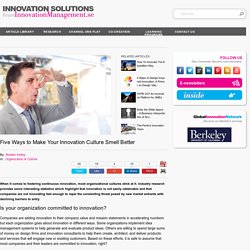
Industry research provides some interesting statistics which highlight that innovation is not easily obtainable and that companies are not innovating fast enough to repel the unrelenting threat posed by new market entrants with declining barriers to entry. Is your organization committed to innovation? Companies are adding innovation to their company value and mission statements in accelerating numbers but each organization goes about innovation in different ways.
Some organizations implement idea management systems to help generate and evaluate product ideas. Others are willing to spend large sums of money on design firms and innovation consultants to help them create, architect, and deliver products and services that will engage new or existing customers. Storytelling about innovation: The Kondratieff 6th Wave.... When working as a business designer and trying to help companies innovate for the future, the main challenge I find, is often not one of designing the new future business area or product, but rather one of creating strong ownership and cross organizational storytelling about this future, that allows management to implement.

I frequently have the pleasure of teaching MBAs in innovation – and the opportunity of testing first hand how storytelling can enhance operational will to implementation. One of my key entry points to this storytelling is the idea of mega trends: How future business design and innovation must be based on long term trends, rather than short business cycles. Leading Your Team into the Unknown. Ask notable innovation leaders what they think about traditional management practices—say, those taught in a typical MBA program—and you get some pretty strong reactions.
Take Elon Musk, a cofounder of PayPal, Tesla, and SpaceX. “At my companies,” he says, “our position is that we hire someone in spite of an MBA, not because of one.” Or Intuit cofounder Scott Cook: “When MBAs come to us, we have to fundamentally retrain them—nothing they learned will help them succeed at innovation.” Nothing? Why is that? We’ve been investigating that question for more than five years now, in the course of our work identifying companies that have earned a significant share-price premium by consistently launching innovative products and entering new markets. They’ve done so by drawing on a wealth of ideas developed over the past 50 years. Incremental Or Radical Innovation: Indian Businesses Want Both. Innovation is the key word today for businesses. Not because consumerism is losing out on loyalists, but because if innovation does not happen on a constant basis, India will lose all the brownie points it has procured in the last few decades post-liberalisation.
Now, the matter of innovation is a lot more serious than just tying it to consumerism. Though innovation happens in all businesses, it is much needed to understand the newer challenges, and innovate to find better and more efficient solutions. The Future of Business Innovation: Invent the Company That Will Put Your Company Out of Business. Design thinking. Four innovation buzzwords you need to know. “Medical armor” is just one of the new buzzwords transforming the way we think about innovation. (Harrison McClary/Reuters)
History of innovation. Platform Business Model. Debunking/critique of disruptive innovation. Innovation myths. The capitalist's dilemma. Skunk. Innovation Strategy. Innovation in the Global South. Open innovation. Measure innovation. Frameworks & Tools. Permissionless innovation. Reverse Innovation.